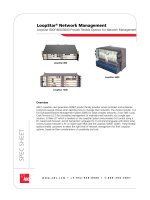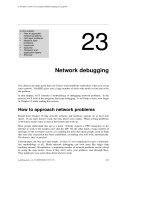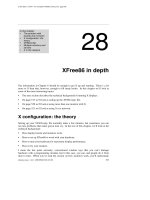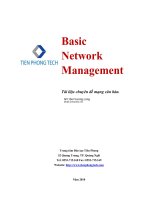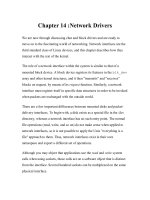Chapter 28 Network Management: SNMP potx
Bạn đang xem bản rút gọn của tài liệu. Xem và tải ngay bản đầy đủ của tài liệu tại đây (1003.92 KB, 39 trang )
Chapter 28
Network Management:
SNMP
28.1
Copyright © The McGraw-Hill Companies, Inc. Permission required for reproduction or display.
28-1
NETWORK MANAGEMENT SYSTEM
We can say that the functions performed by a
network management system can be divided into five
broad categories: configuration management, fault
management, performance management, security
management, and accounting management.
Topics discussed in this section:
Configuration Management
Fault Management
Performance Management
Security Management
Accounting Management
28.2
Figure 28.1 Functions of a network management system
28.3
28-2
SIMPLE NETWORK MANAGEMENT
PROTOCOL (SNMP)
The Simple Network Management Protocol (SNMP) is a
framework for managing devices in an internet using
the TCP/IP protocol suite. It provides a set of
fundamental operations for monitoring and maintaining
an internet.
Topics discussed in this section:
Concept
Management Components
Structure of Management Information (SMI)
Management Information Base (MIB)
SNMP
28.4
Figure 28.2 SNMP concept
28.5
Figure 28.3 Components of network management on the Internet
28.6
Note
SNMP defines the format of packets
exchanged between a manager and
an agent. It reads and changes the
status (values) of objects (variables)
in SNMP packets.
28.7
Note
SMI defines the general rules for naming
objects, defining object types (including
range and length), and showing how to
encode objects and values. SMI does
not define the number of objects an
entity should manage or name the
objects to be managed or define the
association between the objects and
their values.
28.8
Note
MIB creates a collection of named
objects, their types, and their
relationships to each other
in an entity to be managed.
28.9
Note
We can compare the task of network
management to the task of writing a program.
❏ Both tasks need rules. In network
management this is handled by SMI.
❏ Both tasks need variable declarations. In
network management this is handled by MIB.
❏ Both tasks have actions performed by
statements. In network management this is
handled by SNMP.
28.10
Figure 28.4 Management overview
28.11
Figure 28.5 Object attributes
28.12
Figure 28.6 Object identifier
28.13
Note
All objects managed by SNMP are given
an object identifier.
The object identifier always starts with
1.3.6.1.2.1.
28.14
Figure 28.7 Data type
28.15
Table 28.1 Data types
28.16
Figure 28.8 Conceptual data types
28.17
Figure 28.9 Encoding format
28.18
Table 28.2 Codes for data types
28.19
Figure 28.10 Length format
28.20
Example 28.1
Figure 28.11 shows how to define INTEGER 14.
Figure 28.11 Example 28.1, INTEGER 14
28.21
Example 28.2
Figure 28.12 shows how to define the OCTET STRING
“HI”.
Figure 28.12 Example 28.2, OCTET STRING “HI”
28.22
Example 28.3
Figure 28.13 shows how to define ObjectIdentifier
1.3.6.1 (iso.org.dod.internet).
Figure 28.13 Example 28.3, ObjectIdentifier 1.3.6.1
28.23
Example 28.4
Figure 28.14 shows how to define IPAddress 131.21.14.8..
Figure 28.14 Example 28.4, IPAddress 131.21.14.8.
28.24
Figure 28.15 mib-2
28.25
